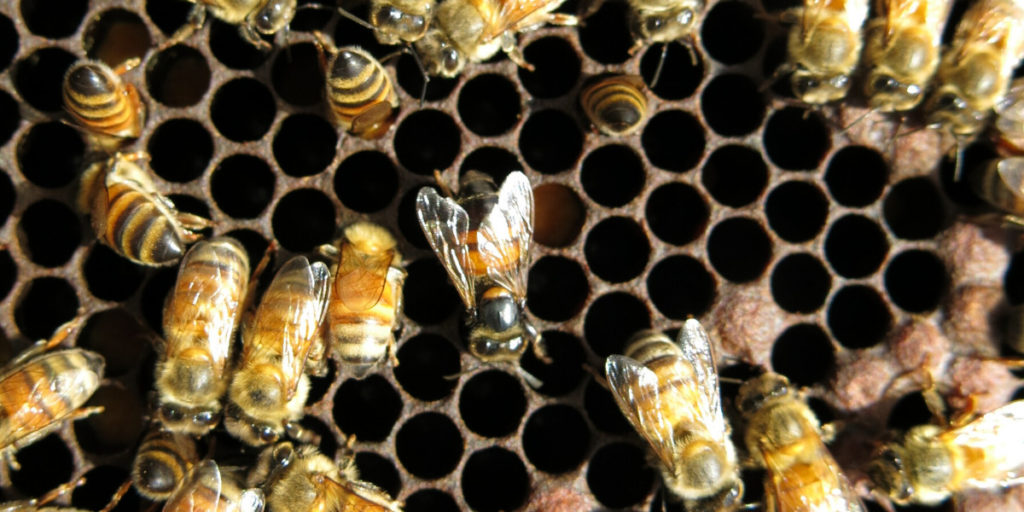Varroa treatments arrived in crime. In a double sense, just bear with me for a while. In a crime series I watched some days ago, the victim was a beekeeper killed while working on his colonies. Beekeeping became so popular in the past years that I see quite a lot of magazines, TV shows, social media etc. taking up the topic. In the episode I watched the other day, the varroa mite made its entrance as the largest threat for honey bee health. Which is correct. Just one thing made me jump up from the sofa: the main beekeeper character said that there’s nothing to treat against it. But instead of writing the TV station, I made notes for this blog post.
A common misconception
A question I get quite often from beekeepers is “When will there finally be something against the varroa mite?”. My answer is always that there already are different varroa treatments. Used properly, they control the parasite sufficiently for healthy and productive colonies. But what beekeepers mean by this question: when will this parasite finally disappear? This, I’m afraid, is something we most probably won’t achieve. Varroa destructor is almost everywhere now. Australia resisted longest and managed to discover some introductions in time. But in 2022, varroa took also down under: you can find more about the current situation here.
However, it’s a common misconception that parasites or diseases can be easily eradicated. In the story of medicine, to my knowledge, the only disease that disappeared completely is smallpox, due to vaccinations. I think I belong to one of the last generations that still have the scar of that vaccine. Other diseases, like polio or measles, are mostly under control. Again because of vaccinations. But they still exist. Back to the varroa mite: you can’t vaccinate against a parasite. You can only control it. There are two ways of doing so: by treatments or by selection for more “resistant” or “tolerant” bees. As I explained in more detail in the post about Darwinian beekeeping, I’m in the team treatment. I have further reasons for my standpoint, which I may discuss in a future post.
Varroa treatments are medicines
Going the treatment route, however, isn’t as easy as it may seem. You have to find a substance that works. That kills the parasite, but not the bees. That doesn’t leave residues in the bee products. Finally, that is safe for the user and the environment. After that, you have to put it in a form the beekeeper can handle easily and correctly. Varroa treatments, in addition, are veterinary medicines for a food-producing animal. This is why these products need a registration, independently if they’re “natural” or not. It’s not to dig deep into beekeepers’ pockets. It’s for safety, for bee health.
This brings me to the second aspect of how varroa treatments arrived in crime. There are companies that use the frustration many beekeepers feel because of the lack of a miraculous solution against the parasite. Others may have difficulties in handling the existing products. In the almost 30 years I’m working with bees, I’ve seen quite a few miracle cures. Only a few weeks ago, I stumbled over a product promising 100% efficacy within 24 hours. I won’t name it here, I don’t want to indirectly help a fraud. Because this is a fraud. Even a penal issue, because the manufacturer didn’t follow the current legislation.
Why varroa treatments matter and what to look out for
While it amuses me that varroa treatments make their way into TV crime shows, I’m not at all amused by the fraudulent activities of this company and all the others before them. I’ve been thinking quite a lot why cases like this always make me so upset. The thing is: bee health is important to me. In this case, by “bees” I don’t mean only honey bees, but also bumblebees and solitary bees. We have quite recent data on how much insufficient varroa treatments affect bumblebees. This is why I care about One Health and Animal Welfare for managed bees.
Healthy honey bees protect their wild relatives. As I said at the beginning, there are several varroa treatments on the market. For the EU, you can find the registered products at the sites of the national authorities, here’s a list for all member states. But to make it easier for you to recognize a “legal” treatment:
- Most importantly, you can easily find the active substance on the product and the label. In general, prefer treatments with a single active substance. The only exception is thymol; here the addition of other essential oils can help. Check this article for some background knowledge.
- The label clearly indicates when and how to use the product.
- There are precise dosages on the label.
- There must be a registration number and a date when the information was last updated.
If anyone promises 100% efficacy, do me the favour: don’t fall in this trap.
Active substances registered in the EU
Finally, here are the active substances in varroa treatments that are common in the EU. The products partially change in the different member states, that’s why I said to look them up in your country.

Personally, I prefer the treatments with organic acids (oxalic or formic acid) and thymol over the synthetic acaricides. However, the latter are usually strips that are very easy to use. This is more suitable for many professional beekeepers with many colonies, but as well for some hobbyists who are insecure on the handling with the “natural” substances. The most important thing: don’t forget the varroa treatments and do it only with registered products.
If you want to know more about Varroa destructor from me personally, contact me with the form below!


